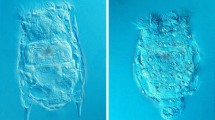Abstract
Hatching experiments were carried out on a population of Brachionus plicatilis (Dor strain) resting eggs produced in batch laboratory cultures under controlled conditions and then stored for at least one month at 4°C in the dark. Light was found to be obligatory for termination of dormancy. Over the temperature range of 10–30°C (at 9.0‰ salinity), hatching was optimal (40–70%) at 10–15°C and decreased linearly with the rise in incubation temperature. Resting eggs incubated over a salinity range of 9–40‰ (at 15°C) showed optimal hatching at 16‰. Incubation of resting eggs in distilled water permitted normal embryonic development, but neonates died at eclosion. Presence of algae, Chlorella stigmatophora (0.5 × 106 cell ml−1), was found to aid hatching.
Access this chapter
Tax calculation will be finalised at checkout
Purchases are for personal use only
Preview
Unable to display preview. Download preview PDF.
Similar content being viewed by others
References
Clegg, J. S., 1964. The control of emergence and metabolism by external osmotic pressure and the role of free glycerol in developing cysts of Artemia salina. J. exp. Biol. 41: 879–892.
Gilbert, J. J., 1974. Dormancy in rotifers. Trans, am. Microsc. Soc. 93: 490–513.
Grice, G. D. & Marcus, N., H., 1981. Dormant eggs of marine copepods. Oceanogr. mar. Biol. Ann. Rev. 19: 125–140.
Ito, T., 1960. On the culture of mixohaline rotifer Brachionus plicatilis O.F. Müller in the sea water. Rep. Fac. Fish. Pref. Univ. Mie 3: 708–740 (in Japanese).
Jennings, R. H. & Whittaker, D. M., 1941. The effect of salinity upon the rate of excystment of Artemia. Biol. Bull. 80: 194–201.
Johnson, J. K., 1980. Effect of temperature and salinity on production and hatching of dormant eggs of Acartia californiensis (Copepoda) in an Oregon estuary. Fish. Bull. 77: 567–584.
Kasahara, S., Onbé, T. & Kamigaki, M., 1975. Calanoid copepod eggs in sea-bottom muds. 3. Effects of temperature, salinity and other factors on the hatching of resting eggs of Tortanus forcipatus. Mar. Biol. 31: 31–35.
Kasahara, S. & Uye, S., 1979. Calanoid copepod eggs in sea-bottom muds. 5. Seasonal changes in hatching of subitaneous and diapause eggs of Tortanus forcipatus. Mar. Biol. 55: 63–68.
Lite, J. C. & Whitney, D. D., 1925. The role of aeration in the hatching of fertilized eggs of rotifers. J. exp. Zool. 43: 1–9.
Lubzens, E., 1981. Rotifer resting eggs and their application to marine aquaculture. Europ. Maricult. Soc. Spec. Publ. 6: 163–179.
Lubzens, E., Fishier, R. & Berdugo-White, V., 1980. Induction of sexual reproduction and resting egg production in Brachionus plicatilis reared in sea water. Hydrobiologia 73: 55–58.
McLaren, I. A., 1966. Predicting development rate of copepod eggs. Biol. Bull. 131: 457–469.
Nipkow, F. 1958. Beobachtungen bei der Entwicklung des Dauereies von Brachionus calyciflorus Pallas. Schweiz. Z. Hydrol. 20: 186–194.
Pancella, J. R. & Stross, R. G., 1963. Light induced hatching of Daphnia resting eggs. Chesapeake Sci. 4: 135–140.
Pourriot, R., Rougier, C. & Benest, D., 1980. Hatching of Brachionus rubens O.F. Müller resting eggs (Rotifers). Hydrobiologia 73: 51–54.
Pourriot, R., Rougier, C. & Benest, D., 1981. Rôle de la lumière et de la temperature dans l’eclosion des oeufs de durée de Brachionus rubens Ehr. (Rotifère). Neth. J. Zool. 31: 637–649.
Ruttner-Kolisko, A., 1969. Kreuzungsexperimente zwischen Brachionus urceolaris und Brachionus quadridentatus, ein Beitrag zur Fortpflanzungsbiologie der heterogenen Rotatoria. Arch. Hydrobiol. 65: 397–412.
Ruttner-Kolisko, A., 1972. Rotatoria. Binnengewässer 26: 99–233.
Sorgeloos, P., 1980. The use of the brine shrimp Artemia in aquaculture. In: Persoone, G., Sorgeloos, P., Roels, O. & Jaspers, E. (Eds.), The brine shrimp Artemia, 3. Ecology, Culturing, Use in Aquaculture. Universa Press, Wetteren, Belgium.
Sorgeloos, P. & Persoone, G., 1975. Technological improvements for the cultivation of invertebrates as food for fishes and crustaceans. 2. Hatching and culturing of the brine shrimp Artemia salina L. Aquaculture 6: 303–317.
Strickland, J. D. H. & Parsons, T. R., 1960. A manual of sea water analysis. Bull. Fish. Res. Bd Can. 125: 185 pp.
Stross, R. G., 1966. Light and temperature requirements for diapause development and release in Daphnia. Ecology 47: 368–374.
Stross, R. G., 1971, Photoperiod control of diapause in Daphnia. 4. Light and CO2-sensitive phases within the cycle of activation. Biol. Bull, 140: 137–155.
Uye, S. & Fleminger, A., 1976. Effects of various environmental factors on egg development of several species of Acartia in southern California. Mar. Biol. 38: 253–262.
Walker, K. F., 1981. A synopsis of ecological information on the saline lake rotifer Brachionus plicatilis Muller 1786. Hydrobiologia 81: 159–167.
Wurdak, E. SM Gilbert, J. J. & Jagels, R., 1978. Fine structure of the resting eggs of the rotifers Brachionus calyciflorus and Asplanchna sieboldi. Trans, am. Microsc. Soc. 97: 49–72.
Author information
Authors and Affiliations
Editor information
Rights and permissions
Copyright information
© 1983 Dr W. Junk Publishers, The Hague
About this paper
Cite this paper
Minkoff, G., Lubzens, E., Kahan, D. (1983). Environmental factors affecting hatching of rotifer (Brachionus plicatilis) resting eggs. In: Pejler, B., Starkweather, R., Nogrady, T. (eds) Biology of Rotifers. Developments in Hydrobiology, vol 14. Springer, Dordrecht. https://doi.org/10.1007/978-94-009-7287-2_9
Download citation
DOI: https://doi.org/10.1007/978-94-009-7287-2_9
Publisher Name: Springer, Dordrecht
Print ISBN: 978-94-009-7289-6
Online ISBN: 978-94-009-7287-2
eBook Packages: Springer Book Archive




